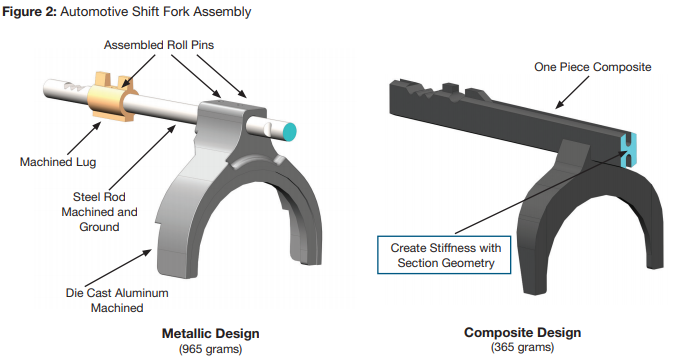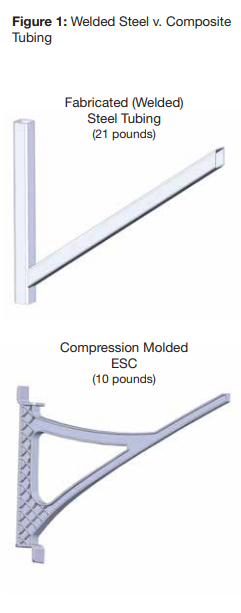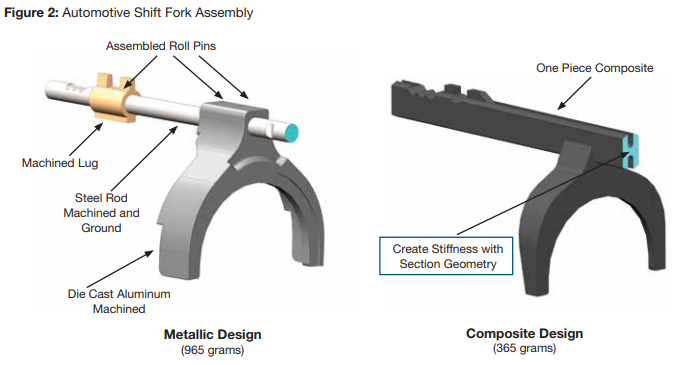

Designing with Composites
When designing with composites, a key question must be addressed up front: Why composites? The answer to this question is likely to determine the direction taken to optimize the design while leveraging the benefits of composites. Cost, weight, performance, part count and complexity are generally the key drivers for a part design, but these can conflict with each other. For example, if lighter weight is the answer to the question “why composites?” the part may require a different design approach than if lower cost or higher performance is the answer. It can sometimes be very difficult to get lighter weight, lower cost and equal or better performance all at the same time. Often, the priority of the design drivers will determine the optimum design. In Figure 1, the tubing was redesigned using composites by adding a tie between the uprights and a complex rib structure to meet the required performance. This resulted in a significant weight savings, but a cost reduction could not be realized compared to the original simple steel-welded component. One design approach to reduce system cost is parts consolidation, with savings realized through inventory reduction and faster assembly. The designer should consider combining parts into a monolithic design, incorporating mating parts and eliminating fasteners and joining operations. Figure 2 illustrates this concept by molding one part to replace three machined and assembled parts. It is particularly important for composite engineers to know and prioritize requirements they are designing to. To really take advantage of composite materials, understanding how the part will be used – including the loads, attachment points, any dimensional constraints, mating parts and the environment in which the material will be used – is a critical first step. It’s important to understand that a functional composite design may not look like the original metallic design. A common mistake designers make when replacing metals with composite parts is trying to make them look the same. This approach is not likely to capitalize on the benefits of composite material. The metallic design was likely modeled with isotropic properties (equal properties in all directions) or perhaps not modeled at all and just over designed to function. Most composite materials have anisotropic properties (different properties in different directions) and should be modeled using those properties. Different forms of composites have different levels of anisotropy. The level of anisotropy is related to the materials and the manufacturing process: Hand lay-up/vacuum bag/autoclave, spray-up, RTM, compression/injection molding, filament winding, pultrusion and other composite fabrication processes all have different anisotropy and thereby need different design approaches. Modeling composites using isotropic properties can be acceptable in some situations when the level of anisotropy is closer to isotropic. Composite molding compounds would be one example of using isotropic properties. However, this should be used as a high-level first look and not a qualifying analysis. Designers need to be mindful of the fabrication process. In Figure 2, the steel rod is round because this is a common shape of steel stock. The mating parts have easily-machined round holes that can be assembled onto the round rod. The composite designer had to achieve the same stiffness, which was accomplished by changing the cross section of the rod component. The designer also had to consider the attachment of the mating parts. In the case of this example, a few of the mating parts have been molded directly onto the rod. Design analysis and modeling with composite materials is now a discipline that is being used by more and more engineers. Engineers in the industry acquire an “empirical” knowledge to instinctively design with composite materials that grows with experience. Errors are commonly encountered when non-composite focused engineers try to substitute a composite material in a metallic design or model it as a metallic material. The metallic design is usually not the optimum design for composite materials. Composite parts can be tailored in a variety of ways. This tailoring can take place in either the part fabrication process or within the material itself. Parts can have localized reinforcement, directionally oriented fibers or more fibers in one direction without added unwanted thickness. As an example, laid-up parts may have more unidirectional fiber layers in the direction of the load path, but enough fiber layers in other directions to handle the forces required in those other directions. Wound parts can have winding angles changed to enhance the properties in specific directions. Random fiber compression molded parts may have localized continuous fiber material added in areas requiring extra strength or stiffness. Similarly, bythe nature of being a “composite” made up of multiple elements, the individual materials themselves are often more easily tailored to meet specific characteristics or even fit a specific application. Composites allow for tailorable solutions. The performance or value is not only in mechanical properties or weight, but also includes aesthetics, conductivity, thermally insulative, ballistic or impact resistance, flame/smoke/toxicity compliance or other valued-added attributes. To summarize, composite design is a complex process that requires consideration of key drivers, including cost, weight, performance, part count and complexity. The relative priority will be influenced by service loads, service environment/performance, connections, specific part requirements, anisotropic properties and the fabrication process. These were briefly touched upon in this column, but all deserve a deeper look to ensure optimal design.

SUBSCRIBE TO CM MAGAZINE
Composites Manufacturing Magazine is the official publication of the American Composites Manufacturers Association. Subscribe to get a free annual subscription to Composites Manufacturing Magazine and receive composites industry insights you can’t get anywhere else.







